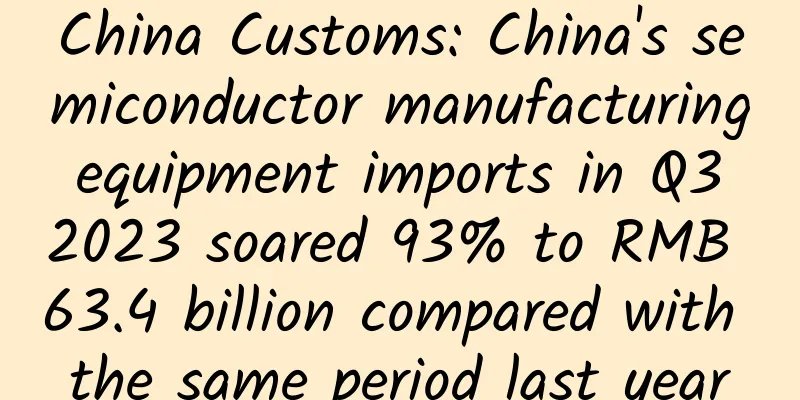China Customs: China's semiconductor manufacturing equipment imports in Q3 2023 soared 93% to RMB 63.4 billion compared with the same period last year

|
According to recent news, although the United States, Japan and the Netherlands have all introduced policies to restrict the export of advanced semiconductor equipment to China, the amount of semiconductor equipment imported by China is still growing rapidly. According to Nikkei, analysis of Chinese customs data shows that China's imports of semiconductor manufacturing equipment in the third quarter of this year (July-September) soared 93% year-on-year to 63.4 billion yuan . In terms of product categories, imports of lithography equipment soared nearly four times . In terms of countries, imports from the Netherlands soared more than 6 times. It is estimated that most of them are lithography products from ASML, the leading lithography company in the Netherlands. Semiconductor equipment imports from Japan grew by about 40%, while imports from the United States only grew by 20%. Judging from the proportion of imports from China's semiconductor equipment source regions in the third quarter, the United States accounted for only 9%, far lower than 17% in 2021. Japan's share also dropped from 32% to 25%, while the Netherlands soared from about 15% to 30%. ASML's third-quarter financial report also showed that its sales revenue from mainland China in the third quarter almost doubled from 24% in the second quarter (sales of approximately 1.345 billion euros) to 46% (sales of approximately 2.442 billion euros). It should be noted that sales revenue from mainland China accounted for only 8% in the first quarter of this year. This further highlights the rapid growth of demand for ASML's lithography systems in the mainland Chinese market. It should be pointed out that the United States began to impose export controls on advanced chips/semiconductor equipment to China in October 2022, and Japan and the Netherlands followed suit this year. Semiconductor equipment takes half a year to a year from ordering to delivery, so it is expected that many manufacturers have already placed large orders for Dutch semiconductor equipment last year. According to the new Dutch semiconductor export control regulations that came into effect on September 1 this year, ASML TWINSCAN NXT:2000i and subsequent immersion lithography systems need to apply for an export license from the Dutch government before they can be exported. However, the NXT:1980 series and below models currently on sale are not affected. ASML's subsequent statement showed that although the export restrictions took effect in September, the company's existing license will allow it to continue to ship NXT:2000i and more advanced DUV lithography machines to China until the end of 2023 . On the evening of October 17 this year, the US government issued the latest export control rules, updating the restrictions on related semiconductor equipment. This will also have a new impact on ASML's exports of related DUV lithography machines to China. In this regard, ASML maintained the same statement as released on October 17 at the earnings conference: “The potential impact needs to be carefully evaluated. For our business, based on the information received so far, we believe that the number of Chinese wafer fabs involved in advanced chip manufacturing that are subject to the new regulations is limited...ASML will further clarify the scope of these new regulations to the US government. ASML continues to be committed to complying with all applicable laws and regulations in the countries where it operates, including export control regulations.” However, the statement from ASML that "the new regulations will apply to a limited number of wafer fabs in China related to advanced semiconductor manufacturing" means that the purchase of DUV equipment and components by a small number of advanced Chinese wafer fabs may be restricted. Peter Wennink only said at the earnings conference that "1980Di will be subject to export control restrictions in principle, but only when used in advanced semiconductor manufacturing and only for a few applications. This means that 1980Di is only prohibited from export to a few wafer fabs, but can be exported directly to the vast majority of mainland China customers for sub-critical and mature processes without a license." Chip Intelligence |
>>: Global iPhone 6 delivery time list: China's version is fastest
Recommend
Tik Tok Operation Script Strategy
1. What is a short video script? A short video sc...
The manufacturer subsidizes 100% of the purchase tax. The new Koleos is priced at 179,800 to 269,800 yuan.
On January 5, Dongfeng Renault's new Koleos w...
Huge profit red envelope project: a WeChat account can earn more than 10 yuan a day, small rules can make 600+ yuan a day, large-scale operations can make more than 10,000 yuan a day
Baidu Netdisk download location: b1-214-Profitabl...
Seres Financial Report: Seres' Revenue in 2024 Will Be 145.176 Billion Yuan, a Year-on-Year Increase of 305.04%, a Record High
According to recent news, SERES disclosed its 202...
App promotion: 11 offline channel promotion methods!
Offline promotion can not only increase the direc...
SEM practical case: How to do Baidu bidding promotion?
There are too many articles about bidding on the ...
Kuaishou advertising, Kuaishou advertising account establishment, Kuaishou advertising resource location
Kuaishou, a short video social platform, has achi...
PC WeChat article one-click export assistant_resource cat, green software download station
A free WeChat article export tool that can export...
Will operators dominate the smart router market?
Abstract: Although communication operators have i...
Why do others have green lights all the way, but you have red lights all the way? Can Mercury retrograde explain it?
The most satisfying moment of driving is to have ...
Can you spend one dollar in channel fees as if it were eight dollars? Let's look at the Six Meridians Divine Sword
What changes have taken place in the way communic...
iQOO Pad review: 144Hz 2.8K 12.1-inch large screen + 6 speakers, a suit thug with excellent sound and picture
IDC's (International Data Corporation) latest...
How much does it cost to be an agent of the Yantai Specialties Mini Program?
For entrepreneurs, although mini program developm...
Electric Technology Car News: Can the stylish exterior and exquisite interior of Jingyi X5 successfully break the existing SUV pattern?
On August 21, Dongfeng Fengxing's Jingyi X6 1...









